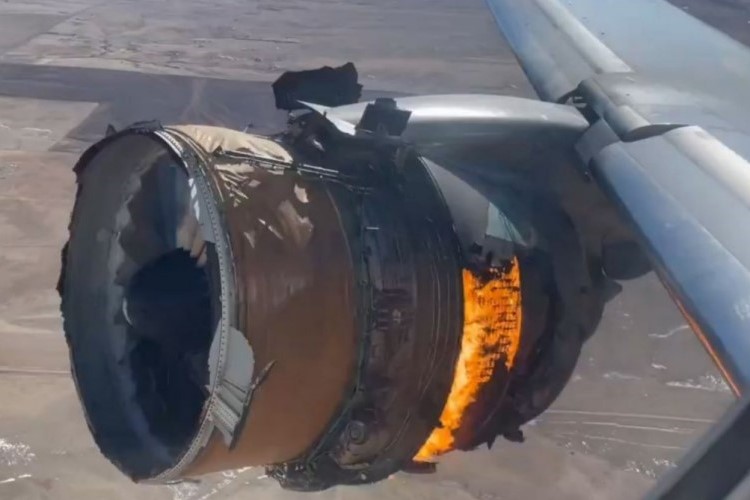The United States (US) National Transportation Safety Board (NTSB) concluded that inadequate inspections, as well as insufficient frequency of inspection intervals, contributed to an uncontained engine failure, or a fan blade out (FBO) event, on a United Airlines flight in 2021.
On February 20, 2021, a United Airlines Boeing 777-200, registered as N772UA, was operating flight UAL328 from Denver International Airport (DEN) to Daniel K. Inouye International Airport (HNL), Honolulu, Hawaii, when shortly after takeoff, the aircraft experienced a failure of the right-hand engine, a Pratt & Whitney PW4000 (PW4077).
The failure resulted in a subsequent fire, with the NTSB detailing that the engine inlet lip skin, fan cowl support beam, and components of the inlet, fan cowls, and thrust reversers (TR) separated from the aircraft.
Reacting to the engine failure, the United Airlines crew declared an emergency, with the captain being the pilot flying (PF), while the first officer was the pilot monitoring (PM). The pilots landed the Boeing 777-200 back at DEN 24 minutes after taking off from the airport. While none of the 293 people onboard, including 10 crew members, sustained injuries, the NTSB said that “a vehicle and a residence sustained damage when impacted by the inlet lip skin and fan cowl support beam, respectively”.
Post-accident PW4000 engine inspection
NTSB investigators found that a separated fan blade and other debris impacted the fan case but were successfully contained. This impact caused damage to the nacelle inner and outer barrels, resulting in the deflection of the fan case and contact with the nacelle doors and hinges. As a consequence, the inlet aft bulkhead and the fan cowl support beam failed, allowing these structures and the inlet lip skin to separate from the engine.
The NTSB discovered that the engine’s carbon fiber reinforced plastic (CFRP) honeycomb structure was unable to handle the loads imposed during this event in the same way as the aluminum structure used during certification tests.
Regulations prohibit the separation of the inlet and fan cowls in such an event. Consequently, Boeing responded by modifying the inlet to ensure they remain in place during damage to the aft bulkhead, inner barrel, or outer barrel.
Boeing also established inspection procedures that address moisture ingression damage to the fan cowls, mandated by two US Federal Aviation Administration (FAA) Airworthiness Directives (AD) issued in March 2022.
The NTSB mentioned that this incident involving United Airlines’ aircraft was the fourth of its kind caused by fatigue cracking on PW4000-powered Boeing 777s and resulted in the most nacelle damage. The first incident in 2010 resulted in the release of around 50% of the blade airfoil, while the subsequent three events, including this one, involved full-span blade separations.
Unable to put out the engine fire
Seconds after the engine failure, the crew received a fire warning on their engine indicating and crew alerting system or EICAS. They were unable to put out the fire due to a failure of the engine’s fire suppression system. The fire warning went away shortly before landing, possibly due to “thermal damage” to the fire sensor.
The NTSB found that the high dynamic activity of the attached main gearbox (MGB) led to the failure of the “K” flange bolts connecting the MGB to the engine. This caused the remaining bolts to fracture, leading to the separation of the flange and the release of hot and compressed gases from the engine core, which ignited in the engine nacelle, causing the fire.
Pratt & Whitney is currently addressing the “K” flange’s weakness, expecting a solution to become available in 2025.
The fire also spread to the Thrust Reversers (TRs), with the burn-through occurring within six to nine minutes of the initial FBO event, which didn’t meet the 15-minute fire resistance requirement.
An inspection of the fire suppression system revealed that the engine-driven hydraulic pump supply shutoff valve failed to close properly due to silicone lubricant contamination of electrical contact components. This valve failure caused hydraulic fluid to leak into the engine compartment, fueling the undercowl fire.
In response, the two aforementioned ADs also required operators to install debris shields on the TR inner wall bifurcation area and repeated inspections of the engine-driven hydraulic pump supply shutoff valves.
Fatigue failure
The NTSB’s report revealed that the engine fan blade broke due to fatigue, with the fracture happening near the fan hub fairing. This fatigue crack began within one of the blade’s hollow cavities.
The engine blade had 2,979 flight cycles (FC) since its last overhaul, with overhaul inspections being required every 6,500 FCs at the time.
The last inspection in 2016 using thermal acoustic imaging (TAI) found several low-level indications, two of which were in the affected area, but they were dismissed as camera sensor noise or contamination.
“Metallurgical examination identified two conditions which contributed to the reduced fatigue life of the accident blade: a surface carbon contamination; and a geometric discontinuity that occurred during manufacturing,” the report read.
As such, the blade should have been inspected with a second TAI. However, United Airlines did not do so.
Following the incident, Pratt & Whitney conducted an immediate TAI on the entire PW4000 fleet before their next flights. The engine maker also issued a service bulletin (SB) to conduct ultrasonic testing (UT) on the blades, as well as increasing the TAI frequency from 6,500 FCs to 1,000 FCs. Eventually, operators began conducting UT inspections every 275 FC.
All in all, the NTSB concluded that the main cause of the incident was the fatigue failure of the right-engine fan blade.
Contributing factors included inadequate blade inspections and insufficient maintenance intervals set by the manufacturer.
Additionally, the NTSB noted that the FBO event was aggravated due to the design and testing of the engine inlet, which failed to ensure the energy from the event was dissipated effectively. The engine fire was made worse by the failure of the “K” flange, fueling the flame in the undercowl area and later, the TRs.

